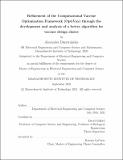| dc.contributor.advisor | Gifford, David | |
| dc.contributor.author | Dimitrakakis, Alexander | |
| dc.date.accessioned | 2022-02-07T15:14:13Z | |
| dc.date.available | 2022-02-07T15:14:13Z | |
| dc.date.issued | 2021-09 | |
| dc.date.submitted | 2021-11-03T19:25:41.195Z | |
| dc.identifier.uri | https://hdl.handle.net/1721.1/139942 | |
| dc.description.abstract | We present the maximum 𝑛-times coverage objective function from a mathematical perspective. Its goal is to select a set number of overlays to maximize a population coverage metric. We formulate two novel algorithms to solve the problem: NTimesILP and WeightSum and compare them to each other and to the MarginalGreedy algorithm [30]. Finally, we link the mathematical formulation of the maximum 𝑛- times coverage problem to epitope vaccine design (OptiVax) and compare various vaccine designs both found in the literature and produced by the three aforementioned algorithms. | |
| dc.publisher | Massachusetts Institute of Technology | |
| dc.rights | In Copyright - Educational Use Permitted | |
| dc.rights | Copyright MIT | |
| dc.rights.uri | http://rightsstatements.org/page/InC-EDU/1.0/ | |
| dc.title | Refinement of the Computational Vaccine Optimization Framework (OptiVax) through the development and analysis of a better algorithm for vaccine design choice | |
| dc.type | Thesis | |
| dc.description.degree | M.Eng. | |
| dc.contributor.department | Massachusetts Institute of Technology. Department of Electrical Engineering and Computer Science | |
| mit.thesis.degree | Master | |
| thesis.degree.name | Master of Engineering in Electrical Engineering and Computer Science | |
